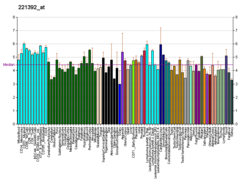
Summary
Taste receptor type 2 member 4 is a protein that in humans is encoded by the TAS2R4 gene.[5][6][7]
| TAS2R4 | |||||||||||||||||||||||||||||||||||||||||||||||||||
|---|---|---|---|---|---|---|---|---|---|---|---|---|---|---|---|---|---|---|---|---|---|---|---|---|---|---|---|---|---|---|---|---|---|---|---|---|---|---|---|---|---|---|---|---|---|---|---|---|---|---|---|
| Identifiers | |||||||||||||||||||||||||||||||||||||||||||||||||||
| Aliases | TAS2R4, T2R4, taste 2 receptor member 4 | ||||||||||||||||||||||||||||||||||||||||||||||||||
| External IDs | OMIM: 604869 MGI: 2681210 HomoloGene: 49480 GeneCards: TAS2R4 | ||||||||||||||||||||||||||||||||||||||||||||||||||
| |||||||||||||||||||||||||||||||||||||||||||||||||||
| |||||||||||||||||||||||||||||||||||||||||||||||||||
| |||||||||||||||||||||||||||||||||||||||||||||||||||
| |||||||||||||||||||||||||||||||||||||||||||||||||||
| |||||||||||||||||||||||||||||||||||||||||||||||||||
| Wikidata | |||||||||||||||||||||||||||||||||||||||||||||||||||
| |||||||||||||||||||||||||||||||||||||||||||||||||||
Function edit
This gene encodes a member of a family of candidate taste receptors that are members of the G protein-coupled receptor superfamily and that are specifically expressed by taste receptor cells of the tongue and palate epithelia. These apparently intronless genes encode a 7-transmembrane receptor protein, functioning as a bitter taste receptor. This gene is clustered with another 3 candidate taste receptor genes in chromosome 7 and is genetically linked to loci that influence bitter perception.[7] The geographic distribution of TAS2R4 and TAS2R5 missense allele variants which prevent expression of the receptors is aligned with the distributions of tannin sorghum and the destructive agricultural bird pest in Africa, indicating the role of human taste in developing agroecosystems fitting local environments.[8]
Ligands edit
Ligands listed in BitterDB include quinine, parthenolide, denatonium, some non-sugar sweeteners including sucralose and stevioside, and several oligopeptides.[9]
See also edit
References edit
- ^ a b c GRCh38: Ensembl release 89: ENSG00000127364 – Ensembl, May 2017
- ^ a b c GRCm38: Ensembl release 89: ENSMUSG00000037140 – Ensembl, May 2017
- ^ "Human PubMed Reference:". National Center for Biotechnology Information, U.S. National Library of Medicine.
- ^ "Mouse PubMed Reference:". National Center for Biotechnology Information, U.S. National Library of Medicine.
- ^ Adler E, Hoon MA, Mueller KL, Chandrashekar J, Ryba NJ, Zuker CS (March 2000). "A novel family of mammalian taste receptors". Cell. 100 (6): 693–702. doi:10.1016/S0092-8674(00)80705-9. PMID 10761934. S2CID 14604586.
- ^ Chandrashekar J, Mueller KL, Hoon MA, Adler E, Feng L, Guo W, et al. (March 2000). "T2Rs function as bitter taste receptors". Cell. 100 (6): 703–11. doi:10.1016/S0092-8674(00)80706-0. PMID 10761935. S2CID 7293493.
- ^ a b "Entrez Gene: TAS2R4 taste receptor, type 2, member 4".
- ^ Wu Y, Guo T, Mu Q, Wang J, Li X, Wu Y, et al. (December 2019). "Allelochemicals targeted to balance competing selections in African agroecosystems". Nature Plants. 5 (12): 1229–1236. doi:10.1038/s41477-019-0563-0. PMID 31792396. S2CID 208539527.
- ^ "hTAS2R4 - Taste receptor type 2 member 4". BitterDB. The Hebrew University of Jerusalem.
Further reading edit
- Kinnamon SC (March 2000). "A plethora of taste receptors". Neuron. 25 (3): 507–10. doi:10.1016/S0896-6273(00)81054-5. PMID 10774719.
- Margolskee RF (January 2002). "Molecular mechanisms of bitter and sweet taste transduction". The Journal of Biological Chemistry. 277 (1): 1–4. doi:10.1074/jbc.R100054200. PMID 11696554.
- Montmayeur JP, Matsunami H (August 2002). "Receptors for bitter and sweet taste". Current Opinion in Neurobiology. 12 (4): 366–71. doi:10.1016/S0959-4388(02)00345-8. PMID 12139982. S2CID 37807140.
- Firestein S (April 2000). "The good taste of genomics". Nature. 404 (6778): 552–3. doi:10.1038/35007167. PMID 10766221. S2CID 35741332.
- Matsunami H, Montmayeur JP, Buck LB (April 2000). "A family of candidate taste receptors in human and mouse". Nature. 404 (6778): 601–4. Bibcode:2000Natur.404..601M. doi:10.1038/35007072. PMID 10766242. S2CID 4336913.
- Ueda T, Ugawa S, Ishida Y, Shibata Y, Murakami S, Shimada S (July 2001). "Identification of coding single-nucleotide polymorphisms in human taste receptor genes involving bitter tasting". Biochemical and Biophysical Research Communications. 285 (1): 147–51. doi:10.1006/bbrc.2001.5136. PMID 11437385.
- Zhang Y, Hoon MA, Chandrashekar J, Mueller KL, Cook B, Wu D, et al. (February 2003). "Coding of sweet, bitter, and umami tastes: different receptor cells sharing similar signaling pathways". Cell. 112 (3): 293–301. doi:10.1016/S0092-8674(03)00071-0. PMID 12581520. S2CID 718601.
- Fischer A, Gilad Y, Man O, Pääbo S (March 2005). "Evolution of bitter taste receptors in humans and apes". Molecular Biology and Evolution. 22 (3): 432–6. doi:10.1093/molbev/msi027. PMID 15496549.
- Go Y, Satta Y, Takenaka O, Takahata N (May 2005). "Lineage-specific loss of function of bitter taste receptor genes in humans and nonhuman primates". Genetics. 170 (1): 313–26. doi:10.1534/genetics.104.037523. PMC 1449719. PMID 15744053.
This article incorporates text from the United States National Library of Medicine, which is in the public domain.







